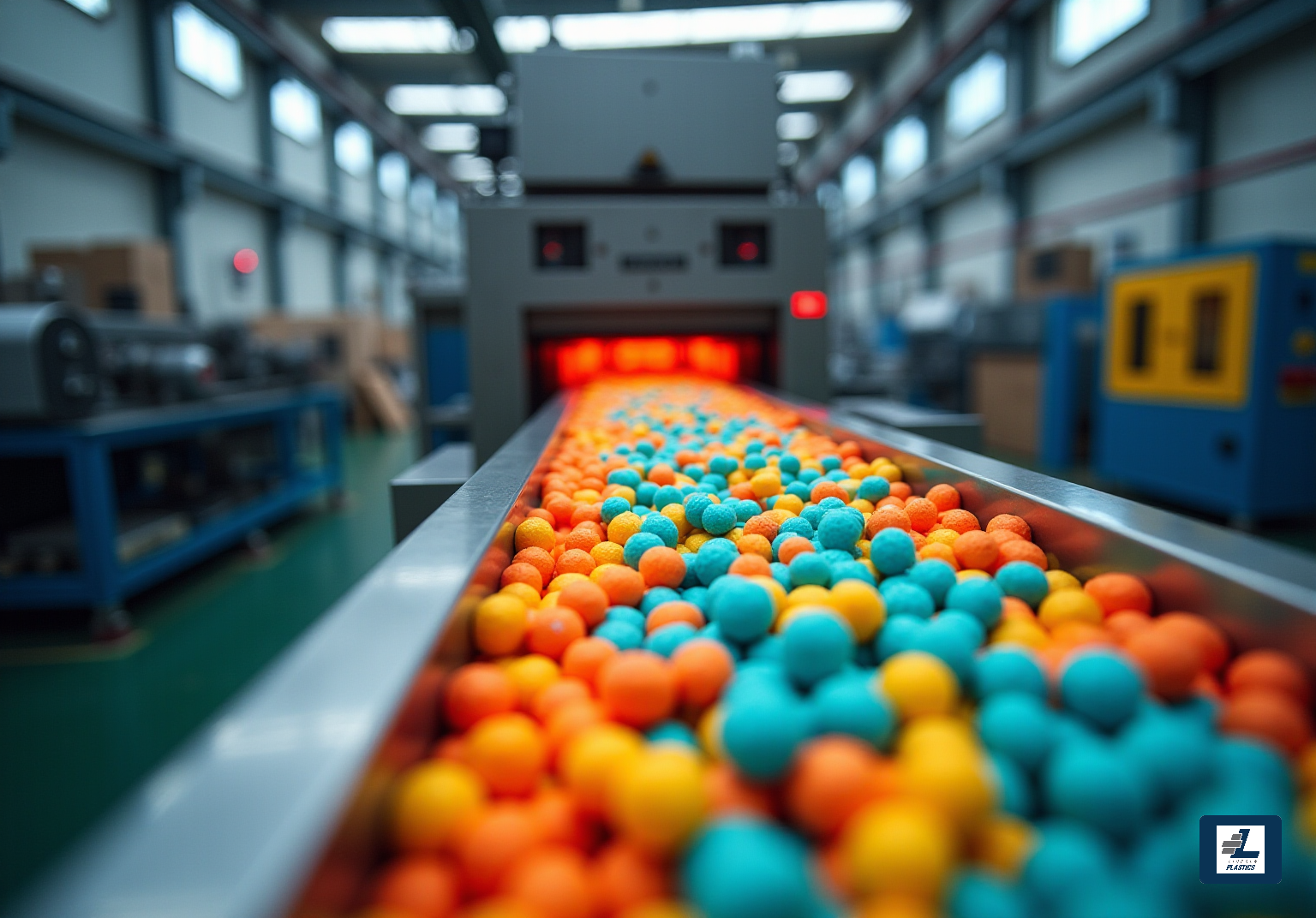
4 Steps to Master the Thermoplastic Extrusion Process
Overview
Have you ever wondered how to master thermoplastic extrusion? It’s not just about the machinery; there’s a process to it! Let’s break it down into four simple steps:
- Material preparation
- Feeding the extruder
- Melting and shaping
- Cooling and finishing
Each of these steps plays a vital role in producing high-quality products.
First off, selecting the right materials is key. You want to make sure you’re starting with the best possible ingredients. Then, there's the feeding of the extruder. This is where you get the material into the machine, and keeping everything flowing smoothly can make a big difference.
Now, let’s talk about melting and shaping. This is where the magic happens! It’s all about maintaining precise temperature controls—too hot or too cold can lead to issues down the line. And don’t forget about optimizing die design; it’s crucial for minimizing defects and enhancing product performance.
Finally, cooling and finishing wrap things up. This step ensures that your product retains its shape and quality. So, what do you think? By following these steps, you can enhance your production process and create amazing products. Ready to dive in and give it a try?
Introduction
In the world of manufacturing, innovative processes are becoming the norm, and thermoplastic extrusion really stands out as a key technique that shapes countless products. This method offers amazing versatility for creating complex shapes and boosts efficiency, making it a top choice for many manufacturers. But let’s be honest—mastering the thermoplastic extrusion process can feel a bit overwhelming, right? There are challenges that can affect product quality and production standards. So, how can manufacturers tackle these intricacies to fully tap into the potential of thermoplastic extrusion?
Understand Thermoplastic Extrusion Fundamentals
Extruding plastics is a big deal in manufacturing! The thermoplastic extrusion process involves melting plastic and pushing it through a die to create continuous shapes. Let’s break down the essential parts of this process:
- Thermoplastics: These materials get soft when heated and harden up when cooled. Common polymers like polyethylene (PE), polypropylene (PP), and polyvinyl chloride (PVC) each have unique traits that suit various uses. For instance, Lincoln Plastics produces custom and standard round shapes in different colors, diameters, and lengths.
- Extruder: This handy machine melts and shapes the thermoplastic. It includes a hopper, barrel, screw, and die, all working together to make sure everything runs smoothly. This efficiency is key to crafting tailored solutions that meet specific client needs.
- Die: Think of this as the mold that shapes the melted plastic into whatever form you need. It’s essential for creating complex designs that meet industry standards. Lincoln Plastics shines here, too, offering flexible shapes and the ability to co-extrude additional colors for even more customization.
- Cooling System: After the extrusion, the item cools down to solidify its shape, ensuring it stays stable and performs well.
Getting to know these components really helps you understand the whole thermoplastic extrusion process and its wide-ranging applications, from construction to automotive and consumer goods.
Key Benefits of Thermoplastic Extrusion
- Versatility: Thermoplastics can create complex shapes and profiles, making them perfect for OEM irrigation products and cable management solutions.
- Efficiency: The continuous production process cuts down on waste and boosts output, making it a smart choice financially.
With the thermoplastic extrusion process, manufacturers like Lincoln Plastics can create tailored solutions that effectively meet specific client needs.
As the industry evolves, there’s a growing focus on sustainability and the recyclability of plastic materials. Lincoln Plastics is all about innovating plastic materials that push forward manufacturing methods, keeping them relevant and beneficial across various applications. Plus, recycling plastic not only reduces waste but also lowers the carbon footprint of production, supporting a circular economy that conserves resources and lessens environmental impact. So, what do you think? Isn’t it exciting to see how far we can go with these materials?
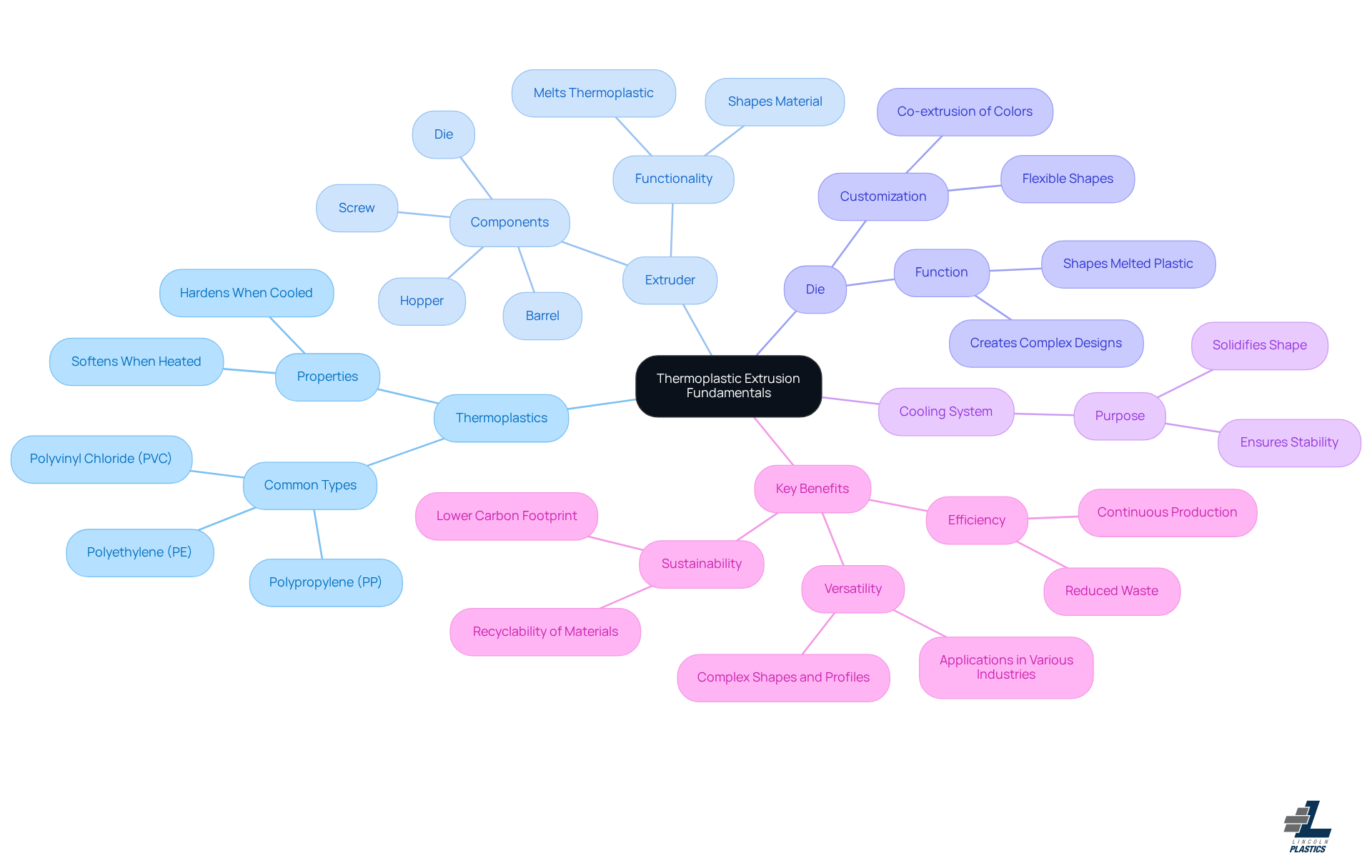
Follow the Step-by-Step Thermoplastic Extrusion Process
To successfully execute the thermoplastic extrusion process, let’s break it down into some easy steps:
-
Material Preparation: First things first, you need to pick the right polymer for your product. Common choices include Polyethylene (PE), Polypropylene (PP), and Polyvinyl Chloride (PVC). Each has its own perks: PE is flexible and resistant to chemicals, PP shines in fatigue resistance, and PVC is durable and versatile. At Lincoln Plastics, we work hand-in-hand with OEMs to ensure your materials meet quality standards. We can even provide specification sheets to help you decide. Just remember, keep the material clean and dry to avoid any defects during extrusion.
-
Feeding the Extruder: Next, load those prepared thermoplastic pellets into the extruder's hopper. It’s crucial to maintain an adequate fill level for a consistent feed rate, which directly affects the efficiency and quality of the thermoplastic extrusion process.
-
Melting the Material: As the screw rotates, it pushes the pellets into the heated barrel. Ensure that the temperature settings for the thermoplastic extrusion process align with the substance's specifications, typically ranging from 180°C to 250°C. For instance, high-density polyethylene (HDPE) needs careful temperature management to avoid thermal degradation, while advanced materials like polyether ether ketone (PEEK) might require higher temperatures due to their superior mechanical properties. If temperatures aren’t managed well, you could end up with defects like bubbles or uneven surfaces. Our robust quality system includes in-process evaluations during the thermoplastic extrusion process to ensure that everything is processed accurately, and we use various check gauges to confirm a suitable end-use fit.
-
Shaping the Material: Once melted, the material gets forced through a die that shapes it into the desired profile. The die design is super important in the thermoplastic extrusion process; it should be tailored to your specific needs to ensure uniform flow and minimize defects. At Lincoln Plastics, we’re here to help optimize your design for manufacturing, making sure the final product meets your specifications.
-
Cooling: After the material exits the die, it needs to cool down to solidify its shape. Cooling methods can vary; some profiles do well with air cooling, while others might need water baths to achieve the right mechanical properties and prevent internal stresses.
-
Cutting and Finishing: Finally, the extruded item is cut to the required length. You might also want to add some finishing touches, like trimming, printing, or surface textures, to meet those strict quality standards. Implementing quality control measures during the thermoplastic extrusion process is essential for ensuring that the final products possess the strength, durability, and appearance that meet industry requirements. We keep an eye on parameters like temperature, pressure, and dimensions to maintain consistent quality. Plus, we offer Vendor Managed Inventory (VMI) solutions to help you manage your inventory effectively, so you can stay within your required min-max ranges.
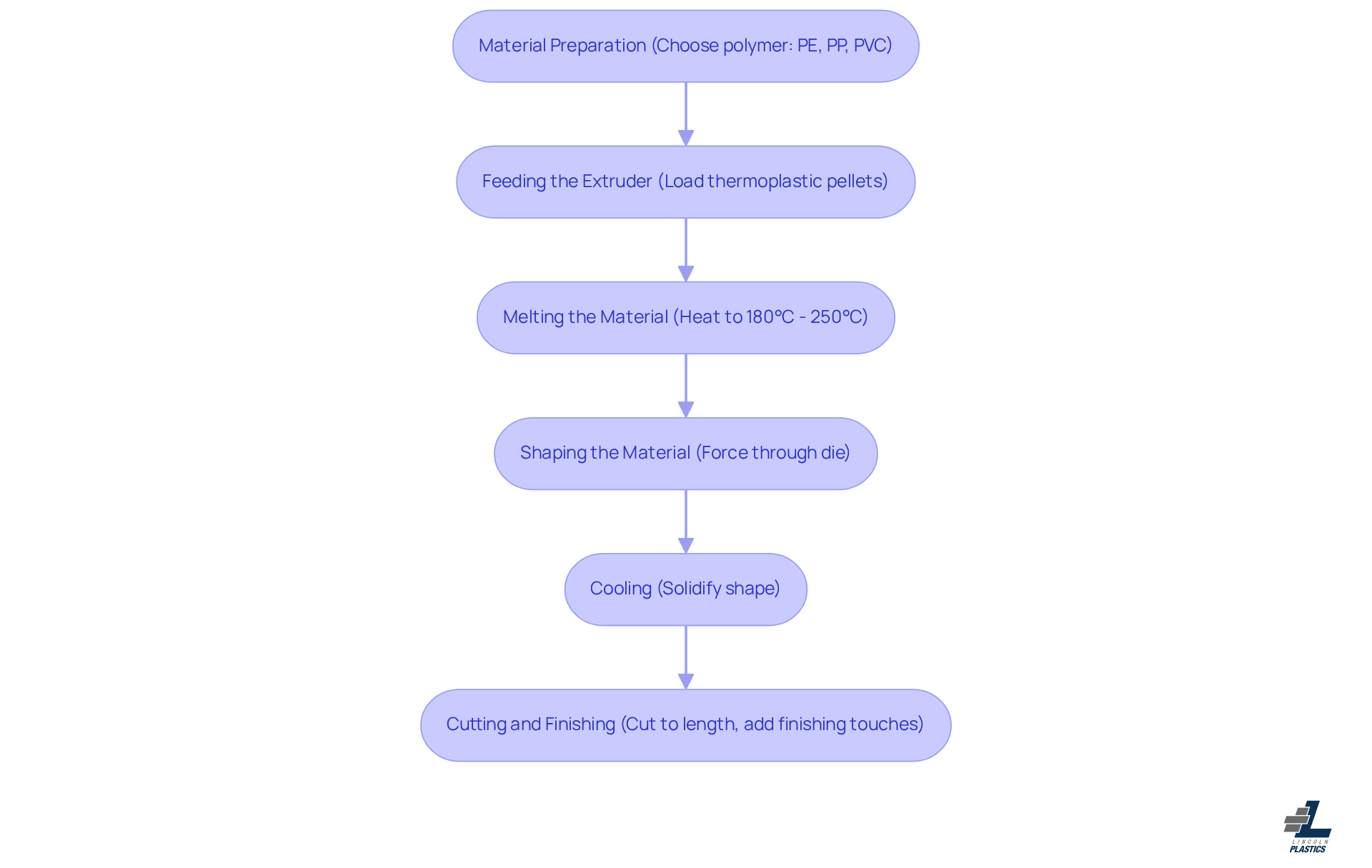
Troubleshoot Common Thermoplastic Extrusion Issues
Common issues in the thermoplastic extrusion process can really impact quality. Let’s dive into some common problems and how to tackle them together:
-
Melt Fracture: Ever noticed a rough surface on your extrudate? That’s melt fracture, often caused by high extrusion rates, poor die design, or even high molecular weight polymers. To fix this, try reducing the screw speed or optimizing the melt temperature. Keeping the temperature just right is crucial—incorrect settings can lead to major surface flaws. At Lincoln Plastics, we partner with OEMs to ensure all quality requirements are met, including special checks for fit and function.
-
Dimensional Inaccuracy: If your extruded products aren’t hitting the mark on dimensions, it’s time to check die alignment and possibly adjust the cooling rate. Dimensional inaccuracies can stem from die design errors or inconsistent temperature management, which complicates assembly and performance. Our robust quality system includes key in-process checks and run documentation to make sure your rigid profiles meet those critical dimensions.
-
Surface Defects: Issues like shark skin or die lines? They usually pop up due to inadequate die design, with abrupt transitions or rough surfaces disrupting polymer flow. Regularly cleaning the die and preventing overheating are essential steps to take. Poor surface finishes can affect both the look and function of the final product, which is why we use various check gauges to ensure a proper end-use fit.
-
Air Traps: Voids in your item can happen if the substance isn’t adequately degassed before extrusion. To avoid this, make sure you have proper venting and keep a consistent feed rate to minimize air entrapment. Effective degassing devices are key to reducing trapped air and preventing surface defects in the plastic.
-
Inconsistent Extrusion: If you’re seeing fluctuations in output, it might be due to variations in substance feed or temperature. Keep an eye on the feed rate and ensure consistent heating throughout the barrel for uniform extrusion. Plus, uneven screw rotation can lead to uneven plastic flow during extrusion.
By spotting and addressing these issues proactively, manufacturers can maintain high production standards in the thermoplastic extrusion process and enhance the quality of their extruded products, ensuring precision and compliance with OEM specifications.
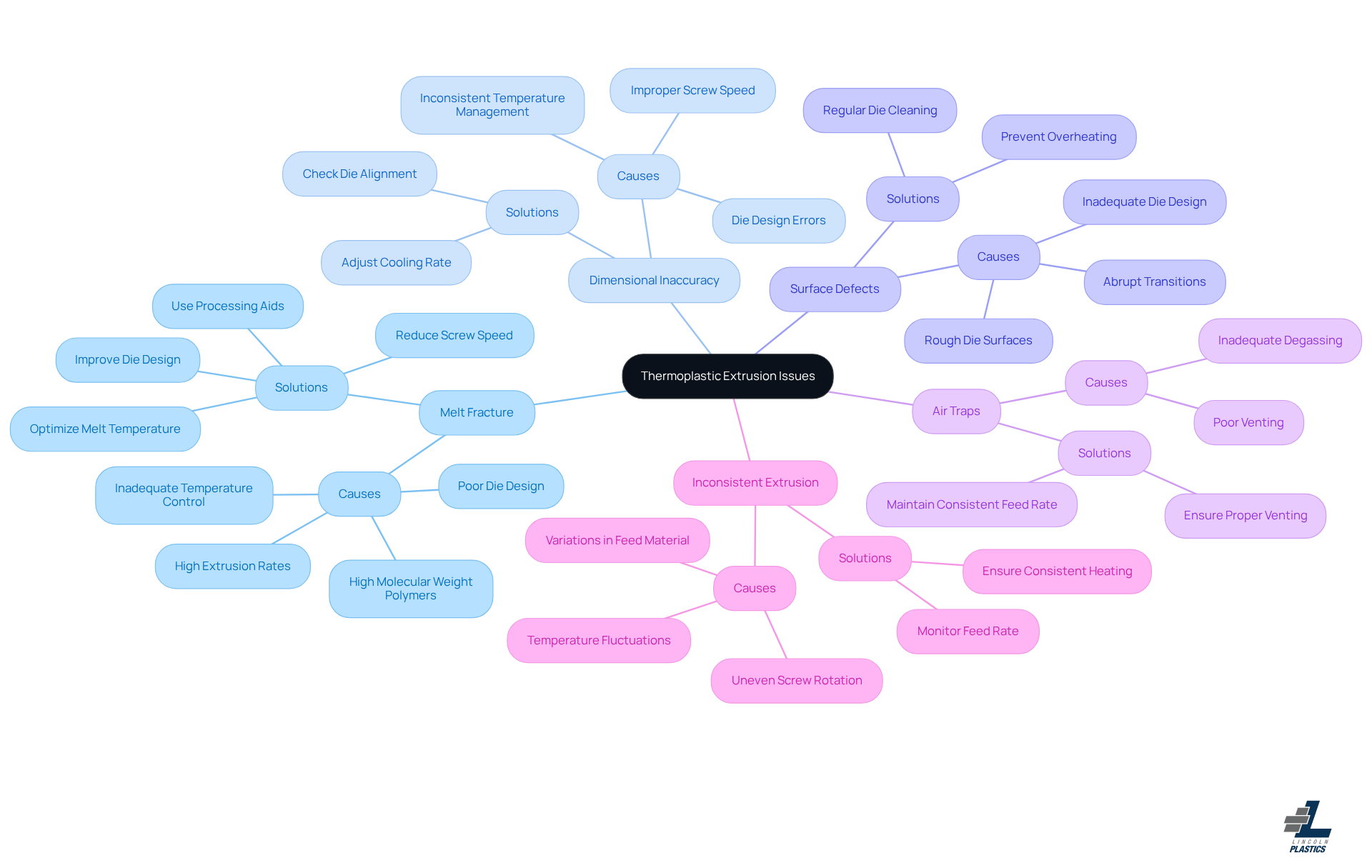
Select Appropriate Materials and Equipment for Extrusion
Choosing the right components and tools is key to the success of the thermoplastic extrusion process. Let’s break it down to ensure you get the best results:
-
Material Selection: When picking thermoplastics, think about a few important factors:
- Mechanical Properties: Look at strength, flexibility, and impact resistance based on what you need. Lincoln Plastics has a range of adaptable profiles in various sizes and materials that can be customized to meet your specific mechanical needs.
- Thermal Properties: Make sure the material can handle processing temperatures without breaking down, keeping its integrity throughout production.
- Chemical Resistance: Choose materials that can withstand the conditions they’ll face in their intended use.
-
Equipment Choice: The extruder you go for should fit your production needs:
- Single-Screw Extruders: These are great for simple profiles and high-volume production, offering efficiency for straightforward applications. Mark Spalding points out that screw design plays a big role in performance here, so it’s crucial to choose wisely.
- Twin-Screw Extruders: Perfect for blending and compounding materials, they’re ideal for more complex designs that need enhanced characteristics. Lincoln Plastics works with OEM engineers to create custom extrusion shapes, minimizing changes and boosting performance.
- Co-Extruders: These allow you to mix different materials, opening up possibilities for innovative product features and better performance. Lincoln Plastics can even co-extrude extra colors into shapes, giving you more customization options.
-
Die Design: Getting the die design right is crucial for achieving the specific shape you want. A well-designed die helps reduce defects and ensures you get the shape you’re aiming for every time. Lincoln Plastics conducts thorough quality checks and keeps a dedicated quality book for your plastic profile, ensuring that everything meets critical dimensions and specifications.
-
Auxiliary Equipment: Don’t forget to add systems like cooling units, conveyors, and cutting machines to make the extrusion process smoother. These enhancements can really boost the efficiency and quality of your products.
By carefully selecting your materials and equipment, you can elevate the thermoplastic extrusion process, resulting in high-quality products that meet strict specifications. With Lincoln Plastics' solid quality system and commitment to collaborating with OEMs, you’ll stay in the loop on the latest trends in thermoplastic materials, giving you a competitive edge in this ever-evolving market.
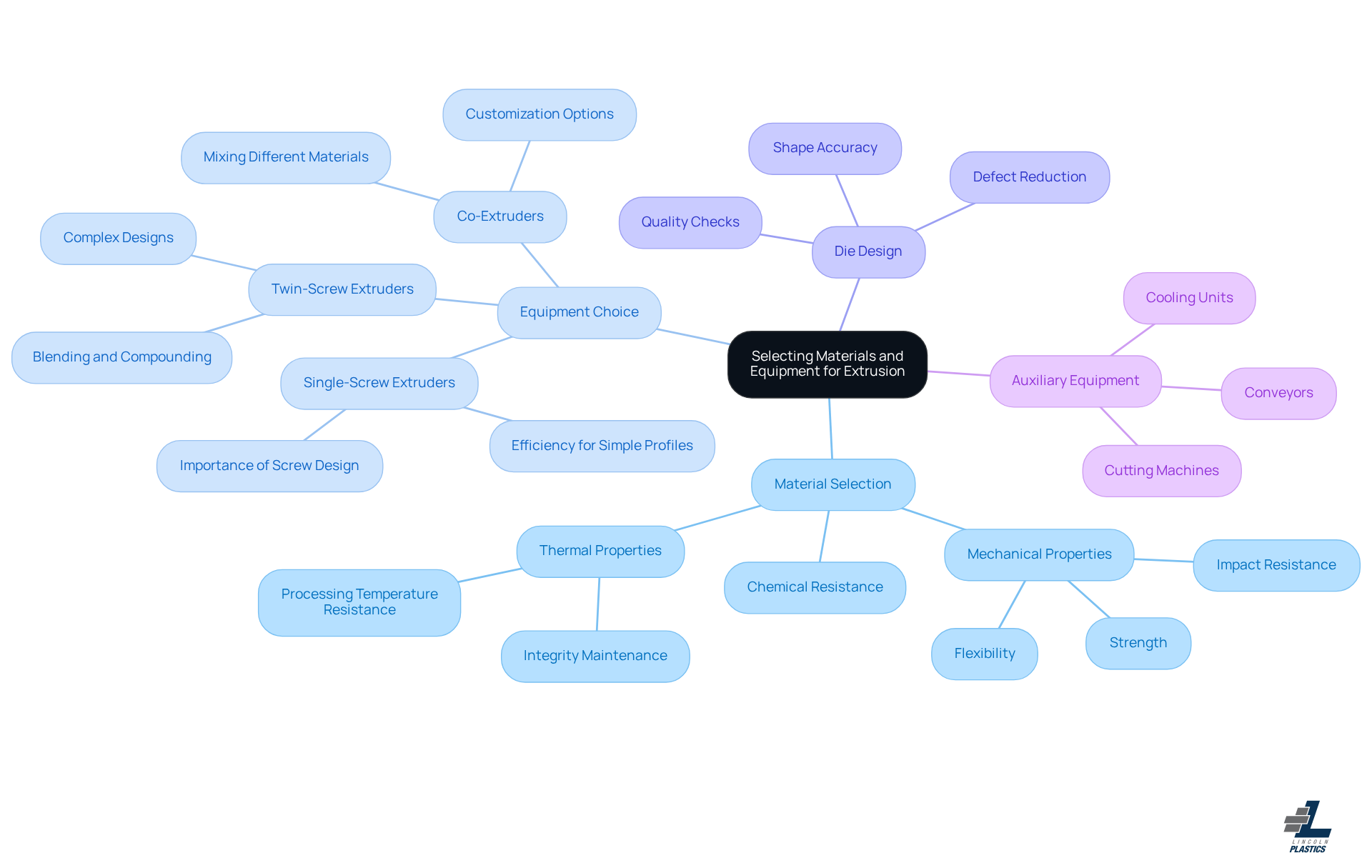
Conclusion
Mastering the thermoplastic extrusion process is key for any manufacturer eager to produce high-quality plastic products efficiently. In this article, we've covered the essential components of thermoplastic extrusion, highlighting why it’s crucial to understand thermoplastics, the role of the extruder, die design, and cooling systems. Each of these elements is vital in making sure the final product meets industry standards and client specifications.
So, what are the key takeaways? The versatility and efficiency of thermoplastic extrusion really shine through, allowing for the creation of complex shapes while cutting down on waste. Our step-by-step guide walks you through everything—from material preparation and feeding the extruder to melting, shaping, cooling, and finishing. This ensures you have a solid grasp of the entire process. Plus, we tackled some common extrusion issues, giving you practical solutions to keep quality and precision on point.
Now, let’s reflect on why thermoplastic extrusion is so significant in manufacturing. It’s clear that picking the right materials and equipment is essential for success. By focusing on quality and sustainability, manufacturers can boost their production capabilities and contribute to a more sustainable future. Embracing the principles of thermoplastic extrusion not only empowers you to innovate but also helps you adapt to the ever-changing market demands, ensuring your competitive edge in 2025 and beyond. So, are you ready to take the plunge into thermoplastic extrusion and elevate your manufacturing game?
Frequently Asked Questions
What is thermoplastic extrusion?
Thermoplastic extrusion is a manufacturing process that involves melting plastic and pushing it through a die to create continuous shapes.
What are thermoplastics, and what are some common types?
Thermoplastics are materials that soften when heated and harden when cooled. Common types include polyethylene (PE), polypropylene (PP), and polyvinyl chloride (PVC), each with unique traits suitable for various applications.
What is the role of an extruder in the thermoplastic extrusion process?
An extruder is a machine that melts and shapes thermoplastic materials. It consists of a hopper, barrel, screw, and die, all working together to ensure efficient production of tailored solutions.
What is a die in the context of thermoplastic extrusion?
A die is a mold that shapes the melted plastic into specific forms. It is essential for creating complex designs that meet industry standards and allows for customization, such as co-extruding additional colors.
How does the cooling system function in thermoplastic extrusion?
The cooling system allows the extruded item to cool down and solidify its shape, ensuring stability and optimal performance.
What are the key benefits of thermoplastic extrusion?
The key benefits include versatility in creating complex shapes, efficiency in continuous production that reduces waste and boosts output, and the ability to meet specific client needs.
How is sustainability addressed in thermoplastic extrusion?
The industry is increasingly focusing on sustainability by innovating plastic materials that support recycling, which reduces waste and lowers the carbon footprint of production, contributing to a circular economy.
List of Sources
- Understand Thermoplastic Extrusion Fundamentals
- The Extrusion Industry in 2025: Innovations, Trends, and Opportunities (https://plextrusions.com/extrusion-blog/the-extrusion-industry-in-2025-innovations-trends-and-opportunities)
- Interplas Insights | Latest Plastics Extrusion Machinery News (https://interplasinsights.com/plastics-machinery/plastics-extrusion-machinery-news)
- Exploring the Versatility of Thermoplastic Parts Across Industries — Automation Plastics Corporation (https://automationplastics.com/news/exploring-the-versatility-of-thermoplastic-parts-across-industries-1)
- Follow the Step-by-Step Thermoplastic Extrusion Process
- Best Practices for the Extrusion of Polymers in Manufacturing (https://lincoln-plastics.com/news-post/best-practices-for-the-extrusion-of-polymers-in-manufacturing)
- Advanced Thermoplastic Extrusion Techniques for Plastic Manufacturing (https://jieyatwinscrew.com/blog/advanced-thermoplastic-extrusion-techniques-for-plastic-manufacturing)
- Shaping the Future: Innovations in Plastic Extrusion Techniques - SeaGate Plastics Company (https://seagateplastics.com/shaping-the-future-innovations-in-plastic-extrusion-techniques)
- News - Understanding the HDPE Extrusion Process (https://faygounion.com/news/understanding-the-hdpe-extrusion-process)
- Troubleshoot Common Thermoplastic Extrusion Issues
- Common problems in the plastic extrusion process | Bausano (https://bausano.com/en/press-and-news/common-problems-in-the-plastic-extrusion-process)
- Troubleshooting Melt Fracture in Profile, Tubing Extrusion (https://ptonline.com/articles/extrusion-troubleshooter)
- What are the common problems with plastic extruders and how to solve them? - Blog (https://parallel-extrusion.com/blog/what-are-the-common-problems-with-plastic-extruders-and-how-to-solve-them-274136.html)
- Common Extrusion Defects & Effective Solutions for Manufactu (https://in.chemtrend.com/news/common-extrusion-defects-how-to-resolve-them)
- Troubleshooting Melt Fracture in Polymer Extrusion (https://uplastech.com/troubleshoot-melt-fracture-extrusion)
- Select Appropriate Materials and Equipment for Extrusion
- Best Practices for the Extrusion of Polymers in Manufacturing (https://lincoln-plastics.com/news-post/best-practices-for-the-extrusion-of-polymers-in-manufacturing?dcc2137a_page=3)
- The Extrusion Industry in 2025: Innovations, Trends, and Opportunities (https://plextrusions.com/extrusion-blog/the-extrusion-industry-in-2025-innovations-trends-and-opportunities)
- Plastics Extrusion | Plastics Technology (https://ptonline.com/topics/extrusion)
- How Will Plastic Extrusion Technology Revolutionize the Next Decade? Deep Dive into Global Trends & Sustainable Solutions - MIDTECH (https://midtech-mc.com/how-will-plastic-extrusion-technology-revolutionize-the-next-decade-deep-dive-into-global-trends-sustainable-solutions)


